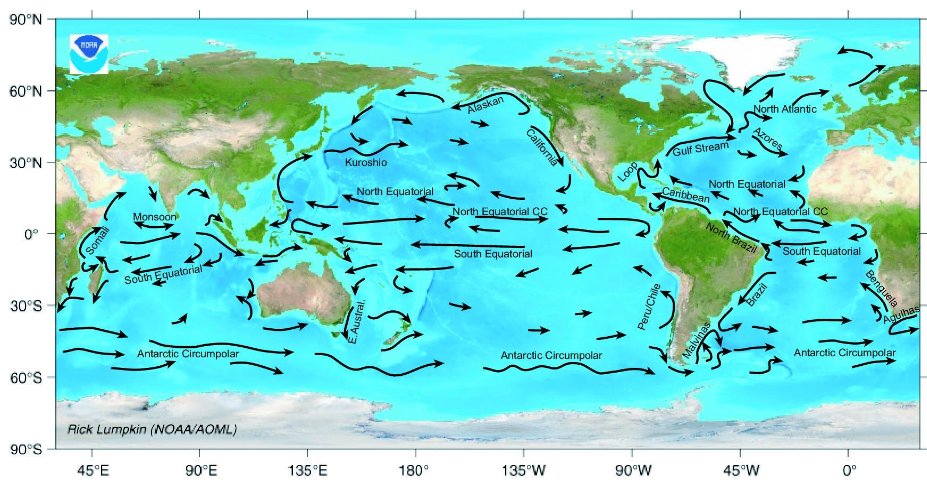Image Source: https://goo.gl/GUDcxe
Summary:
Wind Currents help form Ocean Currents. When comparing an ocean current map to a wind current map, I found out that the ocean current map went the same direction as the wind current map, which must mean that the wind currents affect the direction ocean currents go. Also, wind currents form gyres. A gyre is when water moves in a circle. Gyres are formed when wind blows on opposite sides, opposite directions, and one blowing higher (more north) than the other. This makes the water begin to move. What makes the water move in a circle (gyres) are the landmasses. These allow the moving water to kind of bounce off them and create that circle motion. Without the landmasses, the water wouldn't be bouncing off of anything, and wouldn't create that circle motion.
SP8: Obtain, Evaluate, and Communicate Information:
This week, I obtained data through scientific experiments, reading articles and informational text, and looking at maps of wind and ocean currents and writing down my information. This week, I read about Nike shoes falling into the Pacific Ocean. Then, I plot down where some of the Nike shoes were found. When doing this, I found out that most of the Nike shoes were found at the coast of Western Canada and United States. This made me believe that the Nike sneakers went through 5 Ocean currents to get to the location they were found. When the Nikes were dropped, the North Pacific Current led them to the Alaskan current (which is why most of the Nike shoes found were found along the coast of Western Canada and United States), then down the California Current, across the North Equatorial Current, to the Kuroshio Current. The shoes went along these currents until they were found on land. I evaluated gathered information by discussing it with my team, checking my answers, and seeing if my data was correct. I communicated the information I found with my team.
XCC: Cause and Effect:
I saw that there was a Cause and Effect system between Ocean Currents and Wind Currents. The cause is Wind Currents. Wind currents form Ocean Currents and gyres. The effect of the cause (Wind Currents) are Ocean Currents and Gyres. I know that this Cause and Effect system exists because if you look at a wind current map and put it right next to an ocean current map, you can see that the wind currents go the same direction as the ocean currents. You can also test this system out and see if wind currents form gyres. You will need a tray, water, parsley leaves, and two straws. Fill the tray with water and sprinkle parsley leaves on the water. Then, grab the two straws and put them on both ends of the tray (lengthy sides). Then, take the two straws and put them on either end of the tray (width sides). You should have a tray filled with water with parsley leaves on the top, with one straw on one side near the top edge, and another straw on the other side, at the bottom edge. Now, take one straw and have another person take the other straw, and blow into the straw into the tray of water lightly. You should see that the parsley leaves move in a circle. This is a simulation of how ocean currents and gyres work. The wind currents blow the water, causing wind currents and gyres to form.
Conclusion/Multiplier:
This week, I learned that wind currents affect the way ocean currents move and help form them. I also learned about the formation of gyres and why they move in a circle. This week, I was a Wanderer. This is because I searched for information and shared them with my team.

No comments:
Post a Comment